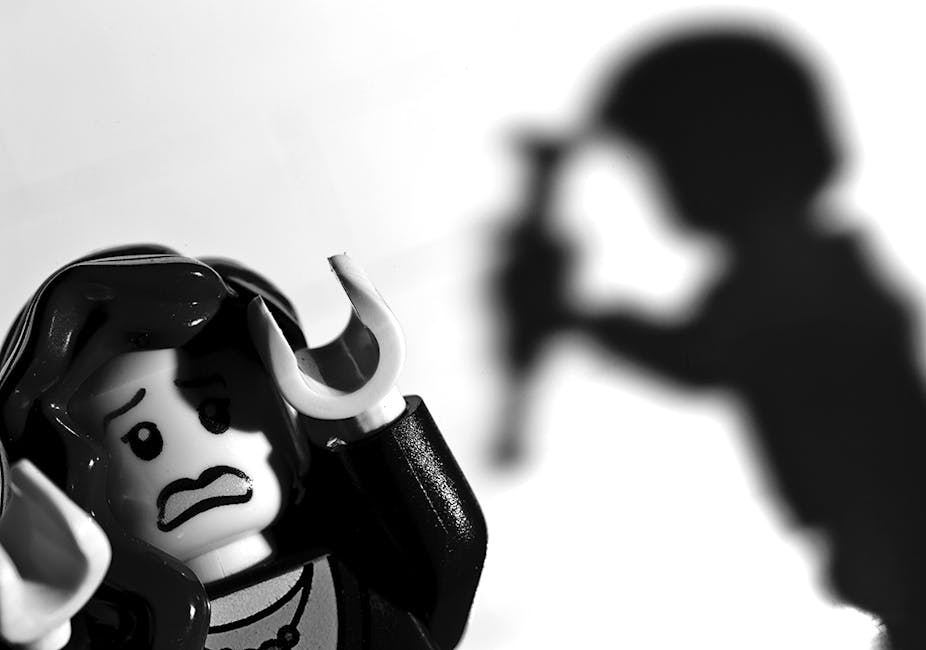Most people find the sight of blood or a hypodermic needle enough to cause some discomfort, but why do some people faint when faced with them? If you’re someone who finds yourself sweating about your upcoming flu jab, you might have your prehistoric ancestors to thank.
Phobias are part of the anxiety disorder family. They are thought to arise because of a learned response to a stimulus following a traumatic event (being bitten by a dog might lead to a fear of dogs), or because of intrinsic adaptive mechanisms that promote survival, which might underlie a fear of spiders or heights.
Most people are familiar with the experience of fear. It may be fear of an upcoming presentation, or of a mouse running across your kitchen floor. Fear is a basic emotion central to the experience of threat, where an animal either fights the threat or runs away.
A phobia, on the other hand, is an intense, pervasive and debilitating fear of something that might seem entirely harmless to others.
The blood-injection-injury phobia
The blood-injection-injury phobia is a fairly common phenomenon. It is experienced by approximately 3% of the population. The phobia can be triggered by the sight of blood, by sustaining an injury, receiving an injection, or some other type of medical procedure.
All humans have a natural tendency to be squeamish in these situations, but for some people the response is more extreme. They experience a temporary spike in heart rate and blood pressure, followed by a dramatic drop. This results in skin pallour, sweating, nausea and fainting.
This fainting response is unique to the blood-injection-injury phobia, in contrast with the usual acceleration of heart rate and elevation in blood pressure in all other phobias.
So why does a fear of blood or needles leave a person weak at the knees, while confrontation with a spider or a Ferris wheel leaves the body armed and ready to fight or run away?
The earliest “adaptationist” hypothesis to explain the blood-injection-injury phobia suggests fainting at the sight of blood increases the chance of survival, because a dramatic drop in blood pressure minimises blood loss in the case of injury. However, this does not explain why people faint when faced with needles or minor injuries, where little or no blood loss is involved.
The second evolutionary hypothesis posits that blood-induced fainting in mammals is controlled by the same physiological mechanism that regulates disgust. It suggests that, in some people, the sight of their own (or another’s) blood might induce a disgust response.
However, disgust (and associated nausea and vomiting) is thought to have evolved to protect mammals from the risk of disease-laden food. It’s difficult to imagine the adaptive benefit of fainting when confronted with bad chicken; simple avoidance seems like a much better approach to maintaining health and survival.
A third explanation describes the adaptive benefit of fainting during periods of inescapable threat in the mid-Paleolithic era. During warfare, confrontation with a “stranger wielding a sharp object” was likely to be associated with threat to life. Humans’ tendency to faint (or “play dead”), rather than attempt to flee or fight, may therefore have evolved as an alternative stress-induced fear-circuitry response.
Epidemiological studies have consistently shown a higher prevalence of blood-injection-injury phobia in women compared with men. Prevalence of the blood-injection-injury phobia also decreases after puberty in boys.
The Paleolothic-threat hypothesis suggests that, during warfare, a phobic response to the sight of blood or an approaching sharp object was likely to be maladaptive for men who engaged in combat. For women and children, however, this behaviour may have been adaptive; fear-induced fainting may have increased the likelihood of being taken captive rather than being killed.
In an interesting research experiment, blood donors were more likely to faint when blood was collected by an experienced phlebotomist rather than an inexperienced phlebotomist.
Consistent with the Paleolithic-threat hypothesis, it was concluded that the novice phlebotomist may have a more deliberate, slower-moving and more talkative approach than their more experienced counterparts. A sharp object held by a fast-moving, non-communicative stranger may resemble more closely a mid-Paleolithic assailant signalling life-threatening danger.
Why do only some people faint?
Heritability estimates are high in the blood-injection-injury phobia; many people report strong family histories, and concurrence of this phobia is high among twins.
Specific phobias, including the blood-injection-injury phobia, are frequently associated with a range of other mental health problems, particularly anxiety disorders. Phobias are also more common in individuals who have endured abuse, neglect or trauma in early life.
Some people might actually be predisposed to fainting due to a dysregulation in their autonomic nervous system. The blood-injection-injury phobia appears to develop in these individuals as a conditioned fear response, after they endure repeated traumatic fainting episodes.
Given its trademark physiological response, traditional methods of relaxation and deep breathing techniques are not the best approach when it comes to a fear of blood, needles or medical procedures. You might find yourself slowing your heart rate and inadvertently accelerating your trip to the floor.
Instead, engaging in conversation, increasing muscle tone and maintaining tension in your body will keep your heart rate up and your dizziness at bay. This could even provide you with enough distraction until it’s all over.

